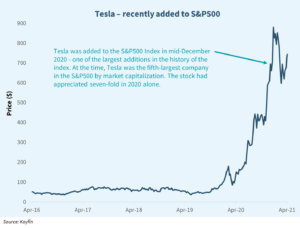Our succinct perspective on key investment and wealth-related issues.
“Risk” is a loaded word that means different things to different people. When it comes to public securities, many investors equate it with volatility or the frequency and magnitude of changes in the price of an asset. We prefer to think of it as the chance of a permanent impairment of capital – paying too much for something and not being able to recoup your investment, let alone earn a respectable return.
Using that lens, we think the best tool for managing risk is knowing what you own. It’s why thoughtful investors spend so much time and effort understanding the fundamentals of their portfolio companies and how they compare to the set of expectations implied by the current share price. Doing this allows an investor to make better decisions, such as capitalizing on opportunities where they are able to buy stocks at a healthy discount to an estimate of intrinsic value and avoiding stocks where the price has drifted so far above any reasonable intrinsic value that a mediocre return is all but guaranteed.
We are seeing more examples of the latter than at any time in the past two decades, something we believe is due in large part to the rise in passive investing.
Passive investing (i.e. buying ETFs) has brought low-cost equity market access to a much broader base of investors, undeniably a positive development. But it also means that a significant portion of the equity market is now owned by investors who have limited knowledge of what they own and what they are paying for it. Make no mistake, going passive is an active decision. Most ETFs are tied to a particular index, be it the S&P 500, NASDAQ 100 or something similar. It’s really just another portfolio, only in this case the composition is more an accident of history than any thoughtful construction. Most indices are market-cap weighted, meaning stocks that have gone up the most become the largest positions, and are in fact at their highest weight at the moment they hit an all-time high. More money in the fund simply means buying more of the existing portfolio/index, with no consideration of the quality, value or price of the respective underlying businesses. A passive portfolio becomes most dangerous in the later stages of a bull market, as complacency sets in at a time when overall valuations are at lofty levels. We think some investors might be surprised by the characteristics of certain positions in their “portfolio.”
As an example, consider Tesla (see chart below) which was recently added to the S&P 500 (meaning for those that own the index it is now a 2% position in their portfolio).
Setting aside any views on Elon Musk or Tesla cars themselves, what does one have to believe about the future of the company to expect a reasonable return on the stock over the next decade? Global auto sales in 2021 are expected to be roughly 70mm vehicles, with electric vehicles representing roughly 5% of the overall market. Tesla has about a 20% market share in EVs, an average selling price of $50,000 and 17% EBITDA margins. If we assume that global auto sales (volumes) rise by 4% per year for the next decade (in line with global GDP), and EV penetration grows to 50% (ICE engines are likely to be a smaller, but non-zero, percentage and some competing technologies like fuel cells may play a role), the result would be roughly 50 million EVs sold in 2031.
Using Tesla’s current figures for market share, average sales price (ASP) and margins would imply roughly $40 billion of free cash flow. At the current market cap of $700 billion, you are paying almost 18x that number…TODAY. And how realistic are those assumptions? Tesla has a huge first-mover advantage, but it is hard to imagine how their 20% EV market share will be sustainable as every major auto company in the world has now pivoted aggressively towards EVs, not to mention new domestic competitors in high-growth markets like China and India. Further, for EV penetration to grow so dramatically and Tesla to maintain market share, it is logical to expect the average selling price of a Tesla will have to come down over time. And what about margins? Only Ferrari has a higher EBITDA margin today among the global public auto manufacturers, with most of the peer group between 10% and 15%. Increased competition from companies with massive scale advantages looking to aggressively grow market share is likely to pressure margins over time. If we assume 10% market share, a 20% reduction in ASP and a contraction in margins to the high end of the peer group, the free cash flow number drops by 60% to $16 billion.
Against the backdrop of a more mature EV industry with intensified competition and a likely normalization in interest rates, it’s hard to argue a capital-intensive auto company should trade for more than 15x free cash flow. That would imply a negative 10% annualized return on the stock over the next decade. We’ve purposely kept this analysis simple, and Tesla bulls are sure to point out all kinds of “optionality” that we haven’t considered such as self-driving (flying?) taxis, insurance and renewable energy storage, but it’s a worthwhile exercise to see what outcome you have to believe to earn a reasonable return from the current price. Many rational investors who would never buy an individual company when presented with facts like these, likely own dozens of them indirectly. We chose Tesla because it’s topical, but there are far more egregious examples within the S&P 500 and NASDAQ today. Caveat emptor.
Over the last five years, the benefits of passive investing have been stretched to a dangerous extreme. As such, it has never been more important for investors to understand what they own. And despite broadly expensive markets, it is possible to construct a relatively concentrated portfolio of opportunities that combine:
- high-quality businesses that are able to grow and sustain high returns on capital for long periods of time, compounding intrinsic value at an attractive rate, and
- companies that are fundamentally mispriced or misunderstood by the market, that offer the prospect of impressive returns simply by having the price reflect their current intrinsic value.



